Input interpretation

NH_3 ammonia + N_2O nitrous oxide ⟶ H_2O water + N_2 nitrogen
Balanced equation
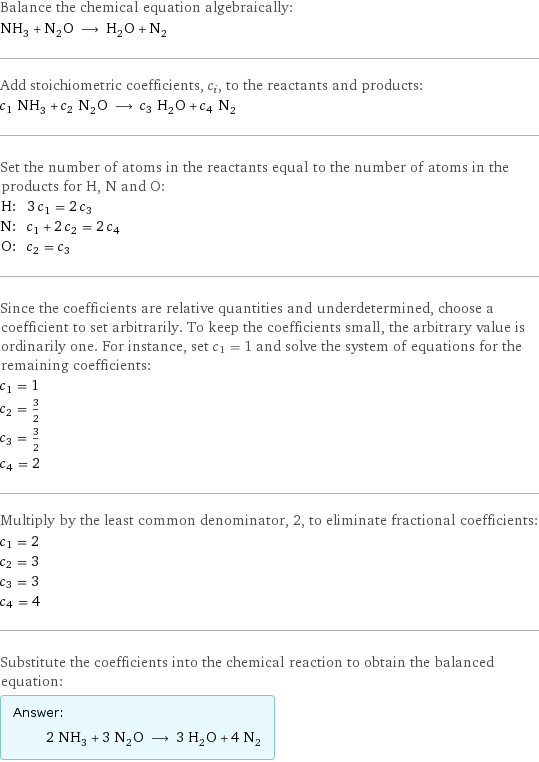
Balance the chemical equation algebraically: NH_3 + N_2O ⟶ H_2O + N_2 Add stoichiometric coefficients, c_i, to the reactants and products: c_1 NH_3 + c_2 N_2O ⟶ c_3 H_2O + c_4 N_2 Set the number of atoms in the reactants equal to the number of atoms in the products for H, N and O: H: | 3 c_1 = 2 c_3 N: | c_1 + 2 c_2 = 2 c_4 O: | c_2 = c_3 Since the coefficients are relative quantities and underdetermined, choose a coefficient to set arbitrarily. To keep the coefficients small, the arbitrary value is ordinarily one. For instance, set c_1 = 1 and solve the system of equations for the remaining coefficients: c_1 = 1 c_2 = 3/2 c_3 = 3/2 c_4 = 2 Multiply by the least common denominator, 2, to eliminate fractional coefficients: c_1 = 2 c_2 = 3 c_3 = 3 c_4 = 4 Substitute the coefficients into the chemical reaction to obtain the balanced equation: Answer: | | 2 NH_3 + 3 N_2O ⟶ 3 H_2O + 4 N_2
Structures

+ ⟶ +
Names

ammonia + nitrous oxide ⟶ water + nitrogen
Reaction thermodynamics
Enthalpy
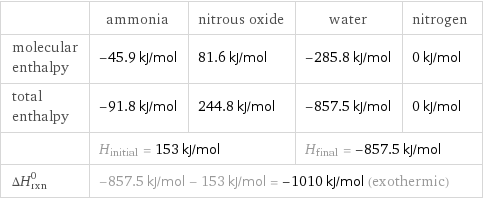
| ammonia | nitrous oxide | water | nitrogen molecular enthalpy | -45.9 kJ/mol | 81.6 kJ/mol | -285.8 kJ/mol | 0 kJ/mol total enthalpy | -91.8 kJ/mol | 244.8 kJ/mol | -857.5 kJ/mol | 0 kJ/mol | H_initial = 153 kJ/mol | | H_final = -857.5 kJ/mol | ΔH_rxn^0 | -857.5 kJ/mol - 153 kJ/mol = -1010 kJ/mol (exothermic) | | |
Gibbs free energy
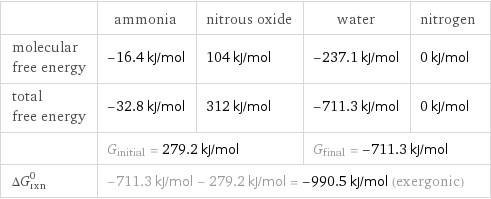
| ammonia | nitrous oxide | water | nitrogen molecular free energy | -16.4 kJ/mol | 104 kJ/mol | -237.1 kJ/mol | 0 kJ/mol total free energy | -32.8 kJ/mol | 312 kJ/mol | -711.3 kJ/mol | 0 kJ/mol | G_initial = 279.2 kJ/mol | | G_final = -711.3 kJ/mol | ΔG_rxn^0 | -711.3 kJ/mol - 279.2 kJ/mol = -990.5 kJ/mol (exergonic) | | |
Entropy
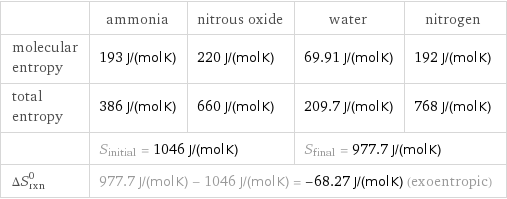
| ammonia | nitrous oxide | water | nitrogen molecular entropy | 193 J/(mol K) | 220 J/(mol K) | 69.91 J/(mol K) | 192 J/(mol K) total entropy | 386 J/(mol K) | 660 J/(mol K) | 209.7 J/(mol K) | 768 J/(mol K) | S_initial = 1046 J/(mol K) | | S_final = 977.7 J/(mol K) | ΔS_rxn^0 | 977.7 J/(mol K) - 1046 J/(mol K) = -68.27 J/(mol K) (exoentropic) | | |
Equilibrium constant
![Construct the equilibrium constant, K, expression for: NH_3 + N_2O ⟶ H_2O + N_2 Plan: • Balance the chemical equation. • Determine the stoichiometric numbers. • Assemble the activity expression for each chemical species. • Use the activity expressions to build the equilibrium constant expression. Write the balanced chemical equation: 2 NH_3 + 3 N_2O ⟶ 3 H_2O + 4 N_2 Assign stoichiometric numbers, ν_i, using the stoichiometric coefficients, c_i, from the balanced chemical equation in the following manner: ν_i = -c_i for reactants and ν_i = c_i for products: chemical species | c_i | ν_i NH_3 | 2 | -2 N_2O | 3 | -3 H_2O | 3 | 3 N_2 | 4 | 4 Assemble the activity expressions accounting for the state of matter and ν_i: chemical species | c_i | ν_i | activity expression NH_3 | 2 | -2 | ([NH3])^(-2) N_2O | 3 | -3 | ([N2O])^(-3) H_2O | 3 | 3 | ([H2O])^3 N_2 | 4 | 4 | ([N2])^4 The equilibrium constant symbol in the concentration basis is: K_c Mulitply the activity expressions to arrive at the K_c expression: Answer: | | K_c = ([NH3])^(-2) ([N2O])^(-3) ([H2O])^3 ([N2])^4 = (([H2O])^3 ([N2])^4)/(([NH3])^2 ([N2O])^3)](../image_source/426df46853ca28d6add14ef1e4ec33dc.png)
Construct the equilibrium constant, K, expression for: NH_3 + N_2O ⟶ H_2O + N_2 Plan: • Balance the chemical equation. • Determine the stoichiometric numbers. • Assemble the activity expression for each chemical species. • Use the activity expressions to build the equilibrium constant expression. Write the balanced chemical equation: 2 NH_3 + 3 N_2O ⟶ 3 H_2O + 4 N_2 Assign stoichiometric numbers, ν_i, using the stoichiometric coefficients, c_i, from the balanced chemical equation in the following manner: ν_i = -c_i for reactants and ν_i = c_i for products: chemical species | c_i | ν_i NH_3 | 2 | -2 N_2O | 3 | -3 H_2O | 3 | 3 N_2 | 4 | 4 Assemble the activity expressions accounting for the state of matter and ν_i: chemical species | c_i | ν_i | activity expression NH_3 | 2 | -2 | ([NH3])^(-2) N_2O | 3 | -3 | ([N2O])^(-3) H_2O | 3 | 3 | ([H2O])^3 N_2 | 4 | 4 | ([N2])^4 The equilibrium constant symbol in the concentration basis is: K_c Mulitply the activity expressions to arrive at the K_c expression: Answer: | | K_c = ([NH3])^(-2) ([N2O])^(-3) ([H2O])^3 ([N2])^4 = (([H2O])^3 ([N2])^4)/(([NH3])^2 ([N2O])^3)
Rate of reaction
![Construct the rate of reaction expression for: NH_3 + N_2O ⟶ H_2O + N_2 Plan: • Balance the chemical equation. • Determine the stoichiometric numbers. • Assemble the rate term for each chemical species. • Write the rate of reaction expression. Write the balanced chemical equation: 2 NH_3 + 3 N_2O ⟶ 3 H_2O + 4 N_2 Assign stoichiometric numbers, ν_i, using the stoichiometric coefficients, c_i, from the balanced chemical equation in the following manner: ν_i = -c_i for reactants and ν_i = c_i for products: chemical species | c_i | ν_i NH_3 | 2 | -2 N_2O | 3 | -3 H_2O | 3 | 3 N_2 | 4 | 4 The rate term for each chemical species, B_i, is 1/ν_i(Δ[B_i])/(Δt) where [B_i] is the amount concentration and t is time: chemical species | c_i | ν_i | rate term NH_3 | 2 | -2 | -1/2 (Δ[NH3])/(Δt) N_2O | 3 | -3 | -1/3 (Δ[N2O])/(Δt) H_2O | 3 | 3 | 1/3 (Δ[H2O])/(Δt) N_2 | 4 | 4 | 1/4 (Δ[N2])/(Δt) (for infinitesimal rate of change, replace Δ with d) Set the rate terms equal to each other to arrive at the rate expression: Answer: | | rate = -1/2 (Δ[NH3])/(Δt) = -1/3 (Δ[N2O])/(Δt) = 1/3 (Δ[H2O])/(Δt) = 1/4 (Δ[N2])/(Δt) (assuming constant volume and no accumulation of intermediates or side products)](../image_source/e547f18173106414417314d604080308.png)
Construct the rate of reaction expression for: NH_3 + N_2O ⟶ H_2O + N_2 Plan: • Balance the chemical equation. • Determine the stoichiometric numbers. • Assemble the rate term for each chemical species. • Write the rate of reaction expression. Write the balanced chemical equation: 2 NH_3 + 3 N_2O ⟶ 3 H_2O + 4 N_2 Assign stoichiometric numbers, ν_i, using the stoichiometric coefficients, c_i, from the balanced chemical equation in the following manner: ν_i = -c_i for reactants and ν_i = c_i for products: chemical species | c_i | ν_i NH_3 | 2 | -2 N_2O | 3 | -3 H_2O | 3 | 3 N_2 | 4 | 4 The rate term for each chemical species, B_i, is 1/ν_i(Δ[B_i])/(Δt) where [B_i] is the amount concentration and t is time: chemical species | c_i | ν_i | rate term NH_3 | 2 | -2 | -1/2 (Δ[NH3])/(Δt) N_2O | 3 | -3 | -1/3 (Δ[N2O])/(Δt) H_2O | 3 | 3 | 1/3 (Δ[H2O])/(Δt) N_2 | 4 | 4 | 1/4 (Δ[N2])/(Δt) (for infinitesimal rate of change, replace Δ with d) Set the rate terms equal to each other to arrive at the rate expression: Answer: | | rate = -1/2 (Δ[NH3])/(Δt) = -1/3 (Δ[N2O])/(Δt) = 1/3 (Δ[H2O])/(Δt) = 1/4 (Δ[N2])/(Δt) (assuming constant volume and no accumulation of intermediates or side products)
Chemical names and formulas

| ammonia | nitrous oxide | water | nitrogen formula | NH_3 | N_2O | H_2O | N_2 Hill formula | H_3N | N_2O | H_2O | N_2 name | ammonia | nitrous oxide | water | nitrogen IUPAC name | ammonia | nitrous oxide | water | molecular nitrogen
Substance properties
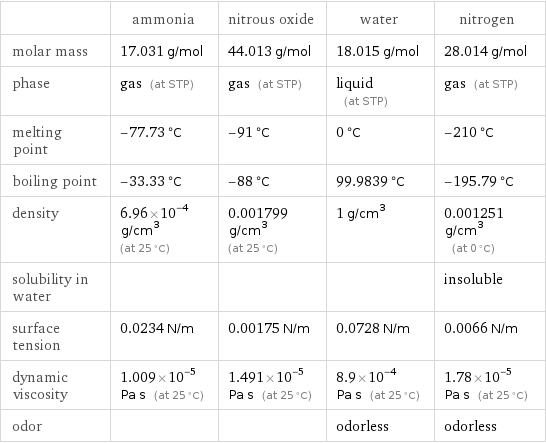
| ammonia | nitrous oxide | water | nitrogen molar mass | 17.031 g/mol | 44.013 g/mol | 18.015 g/mol | 28.014 g/mol phase | gas (at STP) | gas (at STP) | liquid (at STP) | gas (at STP) melting point | -77.73 °C | -91 °C | 0 °C | -210 °C boiling point | -33.33 °C | -88 °C | 99.9839 °C | -195.79 °C density | 6.96×10^-4 g/cm^3 (at 25 °C) | 0.001799 g/cm^3 (at 25 °C) | 1 g/cm^3 | 0.001251 g/cm^3 (at 0 °C) solubility in water | | | | insoluble surface tension | 0.0234 N/m | 0.00175 N/m | 0.0728 N/m | 0.0066 N/m dynamic viscosity | 1.009×10^-5 Pa s (at 25 °C) | 1.491×10^-5 Pa s (at 25 °C) | 8.9×10^-4 Pa s (at 25 °C) | 1.78×10^-5 Pa s (at 25 °C) odor | | | odorless | odorless
Units
